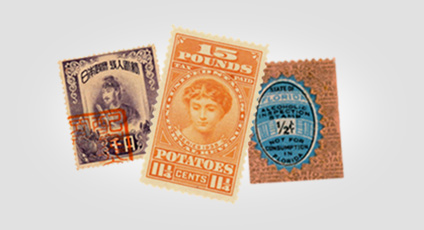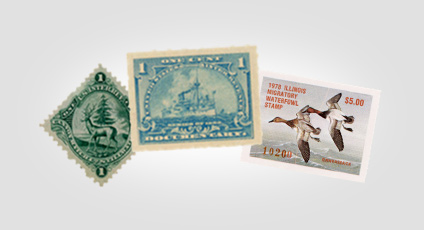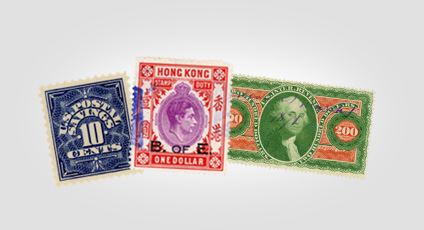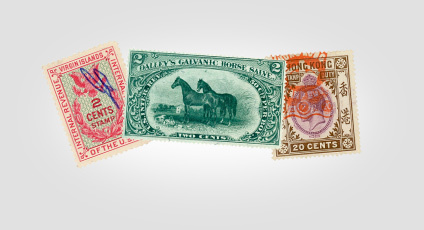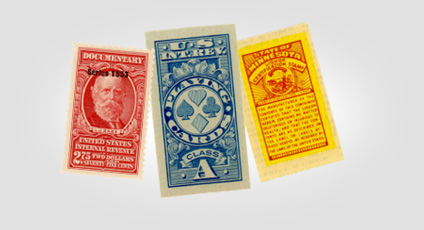Technical Articles
Please Note: Some of the research articles are Adobe Acrobat (PDF) format. PDF files tend to have relatively large file sizes. They may take a long time to download if you have a slow internet connection. Instead of clicking directly on the link to view the article online, you may wish to right click the link and save the file to your computer, for viewing or printing later on.
Stamp Analysis Software
Computational Philately
By Robert V. Mustacich
References to computer-based analysis.
Seeing Only the Cancel
By Robert V. Mustacich
Sometimes the cancels or overprints on stamps are of similar or greater interest than the stamps themselves. This is especially true of proprietary revenue stamps that are often collected primarily for their cancels. This article describes a method for extracting an image of the cancel. The method uses a low resolution histogram of RGB color from an area selected on a stamp image to remove these selected colors from the image. The Cancel Extractor program, based on this research, is a very simple, web-hosted program that selectively removes color from stamp images for the purpose of highlighting cancels.
Freak or Fake? A New Fingerprinting Method for Distinguishing between Original and Fraudulent Extra Perforations of 19th Century Revenue Stamps
By Robert V. Mustacich
This article describes a method which distinguishes between genuine and fraudulent extra perforations commonly found on revenue stamps. These stamps have been controversial for more than a century. Because of the resulting confusion, genuine errors are very often grossly undervalued, while stamps with fake extra perforations can be greatly overvalued. This article explains the “fingerprinting” of perforations and demonstrates that all of the studied fake extra perforations can be traced back to a single perforator. The research shows that a simple test with a transparent specialist gauge can be used to successfully identify most fake perforations.
Fake Perforations on 19th Century U.S. Revenue Stamps: A Stroke of Luck
By Robert V. Mustacich
This research article describes a study of a small stroke perforator of the type that could have been used to create the numerous fake extra perforations on 19th century U.S. revenue stamps. It also includes a survey of the perforation characteristics of a wide range of late 19th century revenue and Cinderella stamps.
Measurements of Stamp Separation Features by Digital Image Analysis
By Robert V. Mustacich
The image analysis of perforation used in the above articles is applied in this research article to entire sheets of stamps from the earliest to the last stamps perforated in the United States. Revenue stamp highlights include studies of First Issue and early 20th century revenue stamp sheets. This survey reveals two events in the quality of rotary perforations as revealed by the stamps themselves — the introduction of air-conditioned machining operations by the contractor Harris Seybold Co. in the 1940s, and the implementation of computer-controlled machining under a special effort by the National Bureau of Standards (now NIST) to specifically address the ongoing contracting problems in procuring rotary harrow perforation cylinders experienced by the BEP in the 1970s. Also of interest to revenue collectors is an example of image analysis methods applied to characterize the early rouletted stamps of Finland.
Digital Image Differencing of High Resolution Stamp Images
By Robert V. Mustacich
The direct digital differencing of high resolution images can be used to directly compare entire images of stamps for microscopic differences arising from plate variations and printing flaws as well as large differences originating from cancels or from the stamps themselves. The possibility of doing this was initially considered unlikely because of expected variability in optical scanning, paper shrinkage differences between stamps, color differences, digital noise, interpolation losses, imperfect image alignments, etc. A combination of scanning protocols and computational methods were found which can limit and correct for these variations to provide direct digital subtractions of one image from another. These approaches go a leap further to compare the relative distortion differences between the individual plate impressions on a printing plate!
Specific applications of this analysis to revenue stamps in this article include the following examples: a high resolution analysis of the “T5” re-entry of the First Issue Bank Check Documentary stamp; the comparison of a series of identical re-entries on the 2 1/2 cent Proprietary Revenue stamp of 1898; the visualization of difficult-to-see plate crack details on the First Issue 15 cent Inland Revenue Documentary stamp; and the relative distortion patterns of the individual printing plate impressions in a large multiple of the 1 cent Proprietary U.S. revenue stamp of 1862.

